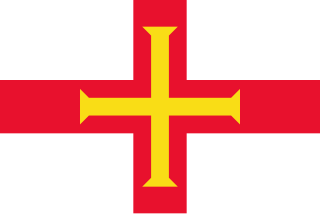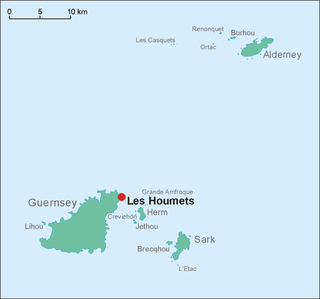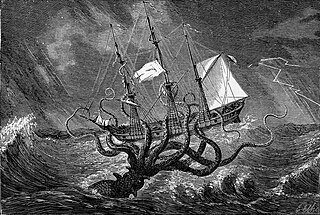
The Channel Islands are an archipelago in the English Channel, off the French coast of Normandy. They are divided into two Crown Dependencies: the Bailiwick of Jersey, which is the largest of the islands; and the Bailiwick of Guernsey, consisting of Guernsey, Alderney, Sark, Herm and some smaller islands. Historically, they are the remnants of the Duchy of Normandy. Although they are not part of the United Kingdom, the UK is responsible for the defence and international relations of the islands as it is for the other Crown Dependency, the Isle of Man, and the British Overseas Territories. The Crown Dependencies are neither members of the Commonwealth of Nations, nor part of the European Union. They have a total population of about 171,916, and the bailiwicks' capitals, Saint Helier and Saint Peter Port, have populations of 33,500 and 18,207 respectively.

Guernsey is the second largest island in the Channel Islands, located 27 miles (43 km) west of the Cotentin Peninsula, Normandy. It is the largest island in the Bailiwick of Guernsey, which includes five other inhabited islands and many small islets and rocks. The Bailiwick has a population of 63,950, the vast majority of whom live on Guernsey, and the island has a land area of 24 square miles (62 km2).

Twenty Thousand Leagues Under the Seas is a classic science fiction adventure novel by French writer Jules Verne.

Victor-Marie Hugo, sometimes nicknamed the Ocean Man, was a French Romantic writer and politician. During a literary career that spanned more than sixty years, he wrote in a variety of genres and forms.

Guernésiais, also known as Dgèrnésiais, Guernsey French, and Guernsey Norman French, is the variety of the Norman language spoken in Guernsey. It is sometimes known on the island simply as "patois". As one of the langues d'oïl, it has its roots in Latin, but has had strong influence from both Old Norse and English at different points in its history.

Ortac is a small uninhabited islet about 5 kilometres west of the coast of Alderney near to the islet of Burhou. It measures roughly 50 by 70 metres, and rises 24 metres above the sea level.

The culture of Guernsey in the Bailiwick of Guernsey is a culture which has been shaped by its indigenous Norman language and traditions as well as French and British cultural influences. Cultural trends from immigrant communities such as the Portuguese have also been added.

St Sampson is a parish of Guernsey, an island in the Bailiwick of Guernsey, directly north of St Peter Port. It is on the north-west and north-east coasts of the island and is split into two sections, intersected by Vale.
Bordeaux Harbour is a fishing port and bay in the parish of Vale in the northeast of Guernsey, about 2 miles (3.2 km) north of Saint Peter Port. The harbour is now used primarily as a beach, which is flat and low, "with stretches of fine sand and groups of boulders".

References to the fictional kraken are found in film, literature, television, and other popular culture forms.

The Minquiers are a group of islands and rocks, about 15 km (9.3 mi) south of Jersey. They form part of the Bailiwick of Jersey. They are administratively part of the Parish of Grouville, and of its Vingtaine La Rocque.
Philippe Victor Diolé was a French author and undersea explorer.

Les Houmets are to the east of Guernsey in the Channel Islands. Their name derives from a diminutive of hou, a Norman/Guernésiais word meaning islets. They are tidal islands.

The kraken is a legendary sea monster of enormous size, etymologically akin to a squid or octopus, said to appear in the sea between Norway and Iceland. It is believed the legend of the Kraken may have originated from sightings of giant squid, which may grow to 12–15 m in length.

Sea Devils is a 1953 colour British–American historical adventure film, directed by Raoul Walsh and starring Rock Hudson, Yvonne De Carlo, and Maxwell Reed. The story is based on Victor Hugo's novel Toilers of the Sea which was the working title of the film. The scenes at sea were shot around the Channel Islands, and much of the rest of the film was shot on location in those islands as well.
Francis William Lionel Collings Beaumont, also known as F. W. L. C. Beaumont or “Buster" Beaumont, was the heir to the Seigneur of Sark, a Royal Air Force officer, film producer and the husband of actress Mary Lawson. He and Lawson were killed in 1941 during the Liverpool Blitz.

Patrick Grainville is a French novelist.

Cephalopod attacks on humans have been reported since ancient times. A significant portion of these attacks are questionable or unverifiable tabloid stories. Cephalopods are members of the class Cephalopoda, which includes all squid, octopuses, cuttlefish, and nautiluses. Some members of the group are capable of causing injury or death to humans.
Toilers of the Sea is a lost 1923 American silent drama film directed by Roy William Neill and starring Lucy Fox, Holmes Herbert and Horace Tesseron. It is an adaptation of Victor Hugo's novel of the same title.
Toilers of the Sea is a 1936 British historical drama film directed by Ted Fox and Selwyn Jepson and starring Mary Lawson, Cyril McLaglen and Andrews Engelmann.

















